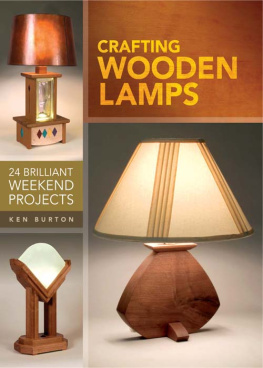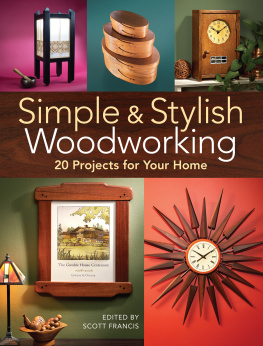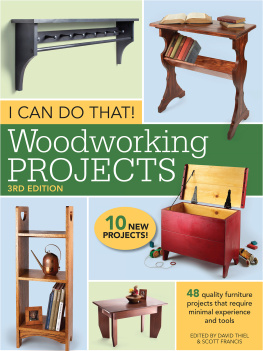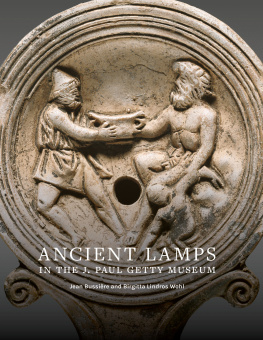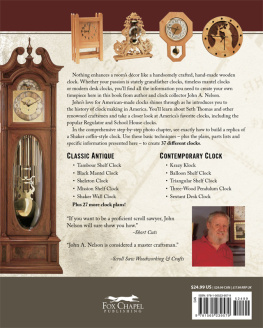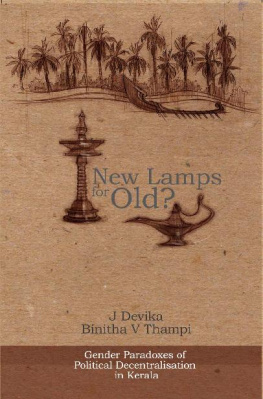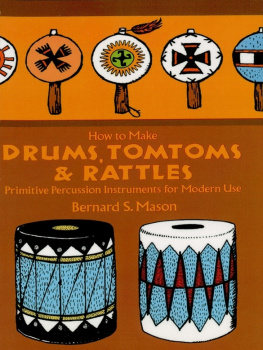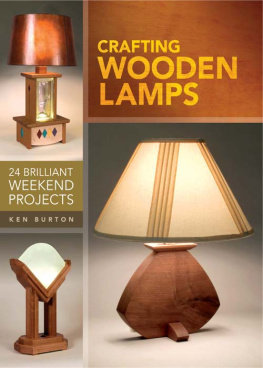CRAFTING WOODEN LAMPS
KEN BURTON


READ THIS IMPORTANT SAFETY NOTICE
To prevent accidents, keep safety in mind while you work. Use the safety guards installed on power equipment; they are for your protection.
When working on power equipment, keep fingers away from saw blades, wear safety goggles to prevent injuries from flying wood chips and sawdust, wear hearing protection and consider installing a dust vacuum to reduce the amount of airborne sawdust in your woodshop.
Dont wear loose clothing, such as neckties or shirts with loose sleeves, or jewelry, such as rings, necklaces or bracelets, when working on power equipment. Tie back long hair to prevent it from getting caught in your equipment.
People who are sensitive to certain chemicals should check the chemical content of any product before using it.
Due to the variability of local conditions, construction materials, skill levels, etc., neither the author nor Popular Woodworking Books assumes any responsibility for any accidents, injuries, damages or other losses incurred resulting from the material presented in this book.
The authors and editors who compiled this book have tried to make the contents as accurate and correct as possible. Plans, illustrations, photographs and text have been carefully checked. All instructions, plans and projects should be carefully read, studied and understood before beginning construction.
Prices listed for supplies and equipment were current at the time of publication and are subject to change.

crafting wooden lamps. Copyright 2011 by Ken Burton. Printed and bound in China. All rights reserved. No part of this book may be reproduced in any form or by any electronic or mechanical means including information storage and retrieval systems without permission in writing from the publisher, except by a reviewer, who may quote brief passages in a review. Published by Popular Woodworking Books, an imprint of F+W Media, Inc., 10150 Carver Rd., Blue Ash, Ohio 45242. (800) 289-0963 First edition.
Distributed in Canada by Fraser Direct
100 Armstrong Avenue
Georgetown, Ontario L7G 5S4
Canada
Distributed in the U.K. and Europe by F&W Media International LTD
Brunel House, Ford Close
Newton Abbot
TQ12 4PU, UK
Tel: (+44) 1626 323200
Fax: (+44) 1626 323319
E-mail:
Distributed in Australia by Capricorn Link
P.O. Box 704
Windsor, NSW 2756
Australia

Visit our Web site at www.popularwoodworking.com.
Other fine Popular Woodworking Books are available from your local bookstore or direct from the publisher.
15 14 13 12 11 5 4 3 2 1
Acquisitions editor: David Thiel
Designer: Brian Roeth
Production coordinator: Mark Griffin
Photographer: Ken Burton
Illustrator: Jim Stack
ABOUT THE AUTHOR

Ken Burton has been working with wood professionally for the past thirty or so years. After more than a decade of playing in his fathers basement shop, he got his formal start through the Fine Woodworking program at Bucks County Community College. From there he collected a Bachelors degree in Industrial Arts Education at Millersville University of Pennsylvania and a Master of Fine Arts in Woodworking and Furniture Design from the School for American Crafts at the Rochester Institute of Technology. At this point, he is pretty seriously over-educated for a woodworker.
Currently, Ken operates Windy Ridge Woodworks in New Tripoli, PA where he designs and builds studio furniture, custom cabinetry and accessories.
In the summer months you can often find him teaching woodworking workshops at the Yestermorrow Design/Build School in Warren, Vermont or at Peters Valley Craft Center in Layton, NJ.
Ken is father to two girls: Sarah, and Emma and is enjoying sharing his love of making things with them. One of Emmas latest projects is a balloon popper which she designed after seeing one in a picture in one of her books.
Despite a huge backlog of projects, Ken generally answers his e-mail in a timely manner. You can contact him through his website: www.wrwoodworks.com.
ACKNOWLEDGEMENTS
The roots of this book run deep, so allow me to say thank you to those people who have encouraged me along the way. I have been quite fortunate to have been taught by some of the finest craftsmen in the country: Jon Alley and Mark Sfirri of BCCC; George Hauber of Millersville University, Bill Keyser, Doug Sigler, and John Dodd of RIT among others.
Thanks too, to the women in my life who have put up with me while I was pulling this whole project together: daughters Sarah and Emma and my partner Janet who has come to mean so much.
And a special shout-out to the crew at F+W Media including David Thiel who managed to put together a great looking publication despite my efforts to miss every deadline.
And finally thanks to Susie Thibodeau and the Asheville-Schoonmaker Mica Co. for being kind enough to supply me with Mica and walk me through the process of how to use it.
DEDICATION
For Emma Janelle Burton who has brightened my life more than any lamp ever could.
INTRODUCTION
MAKING LAMPS IS A GREAT MIX of fine woodworking and mechanical construction, of art and engineering, of aesthetics and practicality. Whether you're building your first lamp, or your hundred-and-first, there are design challenges to overcome and electrical problems to solve: How will you fasten a socket to that lovely piece of burl, Where will the wires run through that graceful bend? How will the thing be turned on and off? Coming up with creative and effective answers to these questions is part of the fun of designing and building wooden lamps.
One of the first things you come up against with lamp design is that there is not a lot of historic precedent. The incandescent light bulb (which made electric lamps possible) wasnt really perfected until the latter part of the 19th century. By this time, quite a few furniture styles had come and gone from fashion. So if you're looking to devise an electric lamp to fit in with your Chippendale-inspired living room suite, youre not going to find a lot of antique examples to copy. Candle holders, maybe, but no electric lamps. So, youll need to improvise, picking up on some of the design motifs from the period youre trying to emulate.
As I was growing up, I watched my father do just this as he made lamps for a furniture shop that specialized in colonial pine furniture. By picking up on some of the detailing and proportions of the other furniture in the genre, my father was able to make a number of different designs that looked quite in keeping with the other period pieces despite their incorporation of relatively new technology.
Speaking of technology, one of the next things you run into as you design a lamp is how to deal with imperfect technology. You may have noticed I put the word perfected in quotation marks earlier when I mentioned incandescent lights. This is because despite better than 100 years of development, the incandescent light bulb is far from perfect. Sure, it has its pluses: it is cheap and gives off a lot of light. But it also has some rather significant negatives: it isnt very efficient in its use of energy it gives off plenty of heat along with the light it produces, and the light it produces is rather harsh. So lamp designs have evolved over the years to deal with these shortcomings. They use shades to temper and diffuse the light and these shades are often designed to dissipate or at least to not trap heat. Unfortunately, there is not a lot that a lamp designer can do to help out with the energy efficiency of a bulb other than to specify the use of a more efficient one. Fortunately, we have some good options to this end. Compact florescent bulbs are much more efficient than incandescents in many applications. Part of this efficiency can be seen (felt?) in how cool they remain when lit. There are also significant advances being made in LED technology to the point where some LED bulbs are now available for general, ambient lighting purposes.

